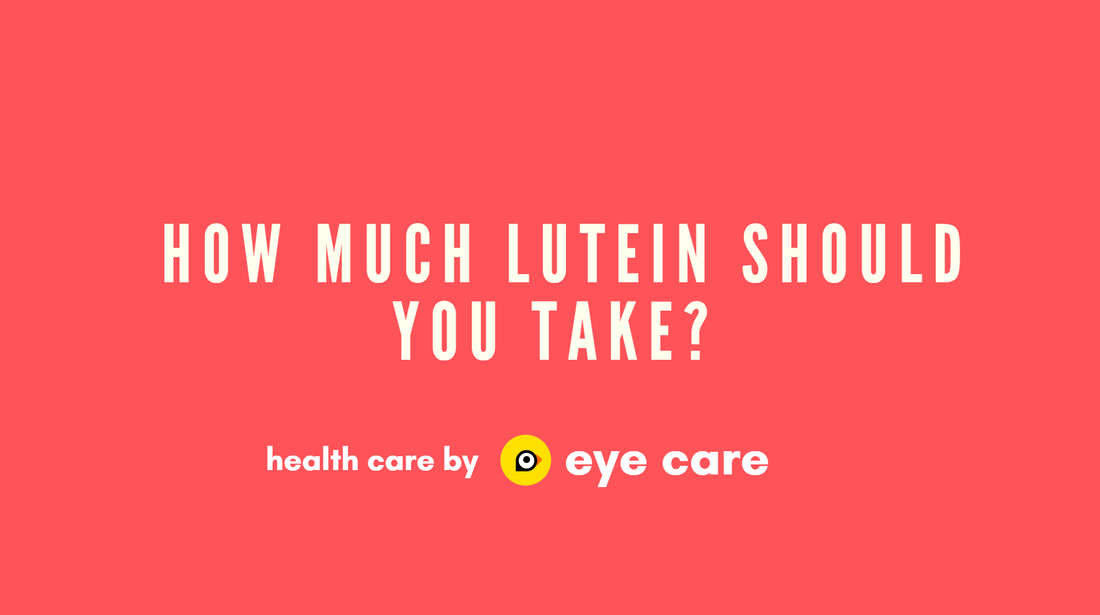
How much lutein should you take for eyes?
Share

The suggested amount was 10mg of Lutein, 2mg of Zeaxanthin, 400mg of Vitamin C, 400 IU of Vitamin E based on the AREDS 2 study for age-related macular degeneration. We need to take more than the RDA and at least the levels associated with health benefits to have a therapeutic effect.
| Nutrient | Recommended dietary allowance (RDA) | Percent getting less than 100% RDA | Levels associated with health benefits | AREDS 2 Study Amounts |
| Lutein and Zeaxanthin | none specified | average intake <1.7mg | > 6 mg | 10 mg Lutein, 2 mg Zeaxanthin |
| Vitamin E | 22-33 IU | >90% | > 100 IU | 400 IU |
| Vitamin C | 90 mg for men, 75 mg for women, +35 for smokers | >50% | > 250 mg | 400 mg |
- Dietary Reference Intakes for Vitamin C, Vitamin E, and Carotenoids. Institute of Medicine, 2000.
- Dietary Reference Intakes for Vitamin A and Zinc. Institute of Medicine, 2001.
- Vitamin and mineral data were obtained from CSFII, 1994-1996. Values correspond to all individuals.
- Carotenoid data was gathered from NHANES III, 1988-1994.
Can I take more than 10 mg of Lutein?
There is limited amount of studies done on the maximum amount of lutein you should take per day, but 20 mg is considered safe.
Not all type of Lutein is the same.
Free lutein in lipid form is best absorbed by the body. A single egg contains about 0.20 mg of free lutein. The average intake of lutein is <1.7mg. Our eye care vitamins from Herbaland contains free lutein sourced from organic marigold flowers, which has 10mg of Lutein per serving. Check out our Puffinbox Nutrition Kit for Kids and Adults, which can be delivered to your door.
Sources of Lutein & Zeaxanthin (mg/per serving)
| Food Per Serving (1 cup) | Lutein | Zeaxanthin |
| Kale | - | 1.1 - 2.2 |
| Collard Greens | - | 5.1 |
| Spinach | 1.7-13.3 | 0.5-5.9 |
| Broccoli | 1.4-1.6 | - |
| Corn, yellow | 0.6 | 0.9 |
| Peas, green | 2.2 | - |
| Orange pepper | - | 1.7 |
| Tangerine | - | 0.2 |
| Egg (1) | 0.2 | - |
*depending on variety and preparation
Sources of Vitamin E (mg/per serving)
| Food | Amount | Vitamin E |
| Almonds | 1/4 cup | 13.9 IU |
| Sunflower seeds | 1/4 cup | 8.7 IU |
| Safflower oil | 1 tbsp | 7.0 IU |
| Peanuts | 1/4 cup | 4.9 IU |
| Peanut butter | 2 tbsp | 4.8 IU |
| Corn oil | 1 tbsp | 4.2 IU |
Sources of Vitamin C (mg/per serving)
| Food per serving (1 cup) | Amount | Vitamin C |
| Orange juice, freshly squeezed | 1 cup | 124 |
| Grapefruit juice, freshly squeezed | 1 cup | 94 |
| Cantaloupe | 1/4 melon | 86 |
| Orange | 1 medium | 80 |
| Green peppers, raw chopped | 1/2 cup | 67 |
| Tomato juice | 1 cup | 44 |
| Strawberries | 1/2 cup | 43 |
| Broccoli, raw chopped | 1/2 cup | 41 |
Why is Eye Nutrition Important?
Age-related Macular Degneration (AMD) is the leading cause of blindness over age 60. AMD impacts of our central vision - visual acuity, which is important for visually-demanding daily activities, like reading, driving, writing and seeing people's faces.
Pregnant women require daily source of Lutein and DHA (from Omega-3) for proper development of the baby's brain and eyes. This is especially critical during the first 3 months. When the baby is born, the eyes are still developing and its important to have healthy eyes since 80% of learning is done through vision.
Check out our Puffinbox Nutrition Kit for Kids and Adults, which can be delivered to your door. They are sugar-free, vegan-friendly, plant-based, and sourced from organic fruits and vegetables. Protection is key to life-long healthy eyes. Your eyes will thank-you.



